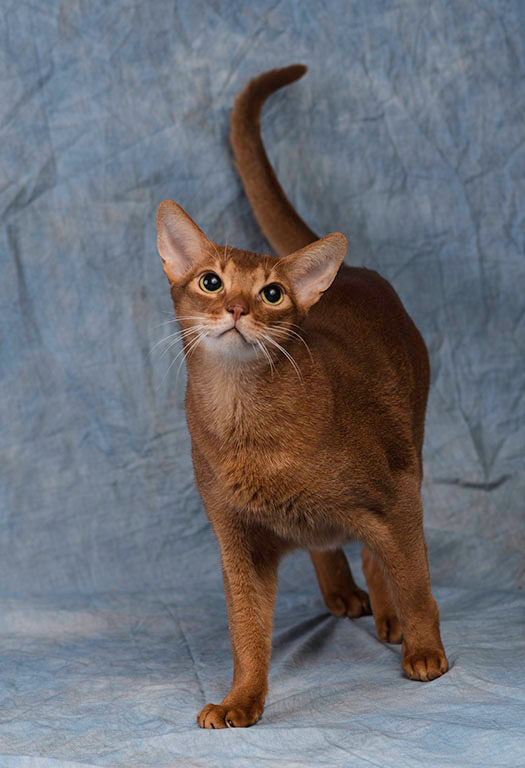
This blog title is a bold claim I know, so I’d like to start by offering an observation about a ‘perfect euthanasia’. What is and isn’t deemed perfect, with regards to the pet’s experience, the human loved ones left behind, and veterinary team’s involvement, is highly subjective. We require the full context of the experience to leave us with the proper judgement of indeed “yes, perfect” or……”maybe not so much”. If not perfect per se, for the purpose of this article, it only means the experience could have been improved upon in some way. The pet ideally still had a very meaningful and peaceful end of life experience. What I know for sure is that veterinary teams, carrying out the act of euthanasia, for usually thousands of pets in our professional careers, will from time to time have one that really stands out; one that makes a veterinarian and/or support team think to themselves, “If only they could be like that 100% of the time.”
This is Rennie. Rennie was a 14-year old, male Abyssinian cat who was intelligent, adventurous, and sweet as pie. With the plan of delivering a perfect euthanasia, I followed CAETA’s 14 Essential
Components of Companion Animal Euthanasia. We started off the best way possible by being at home. Rennie was in his safe place, going about his normal
daily routine, albeit in a weakened state, and pleased to see me. I had been working with Rennie for 2 years due to chronic organ failure and we had developed a kind rapport together. His feline brother Albie was there, along with his doting Mom and Dad, while feline sister Grace was napping in the other room. Rennie had no anxiety, and instead was content examining my things and swishing around his long sultry tail. We gathered on the sun porch to talk for a bit and make sure everything was in order for the family’s wishes. We had already completed a fair amount of preplanning to ensure Rennie received the kind, respectful last moments they were looking for. I shared with the family a pet loss guide dedicated to Rennie and took time to describe my next steps. The pace was slow and uncomplicated, making us feel like we wanted to wrap ourselves in it, especially with the turmoil of emotions happening inside. There was no need to rush.
Rennie would be given a pre-euthanasia anesthetic injection to induce a very deep sleep before the final euthanasia solution was administered. It is well known by veterinary teams that many cats do not like the anesthetic injection, so we have to use extra caution to reduce pain. Rennie was lying on his side in the sunshine, occasionally flicking his tail to remind us of his alertness. I slowly inserted the small needle into his thigh muscle and pushed in my medicine. No reaction (I had blended my drugs to reduce the risk of stinging as best I could). Rennie didn’t even lift his head. In fact, while the medicine was working through his body, he never raised his head again. Rennie just went to sleep. It was exactly what we had hoped for. Mom, Dad, brother Albie, and myself created a circle of love around him and waited patiently until he was in the deep state of sleep. We quietly shared stories about his life while they stroked his velvety fur. When Rennie was fully anesthetized, and the family softly declared they were ready to proceed, I gave the final injection of euthanasia solution. Rennie took one big breath, exhaled, and was gone. The smooth, gentle nature of the passing was so welcomed. Mom and Dad remained close by his side for as long as they needed.
We made a paw print and I excused myself to go get his special transport basket for the drive to the crematory while the family took private time with him. When I returned, brother Albie took time to explore the basket I’d set on the ground near Rennie’s body. He also explored Rennie, smelling him delicately. Sister Grace remained napping. We carried Rennie out to my vehicle like a small funeral procession and tucked him in with one last kiss for his next journey. As I was preparing to leave, Mom and Dad invited me into the back yard to see Rennie’s special daylily growing in the garden.
This case exemplifies a few key elements that made it extra special:
- Zero response to pre-euthanasia anesthetic
injection - Well performed euthanasia technique
- Slow, reverent pace
- Loved ones fully invited to participate
It’s important for veterinary teams to follow a euthanasia blueprint. What is the best possible euthanasia experience we can deliver, and once we know what that is, how do we achieve it? Since 2006, I have helped well over 10,000 pets achieve a beautiful passing, and many of them could have easily been the focus of this story. In the face of recent stories of dysthanasia shared with me by frustrated families across the world, I wanted to remind us of what we are striving for, whether in the hospital or home setting. Every appointment is unique, and factors will come into play that organically shift many euthanasia experiences from perfect to ‘acceptable and still outstanding’. And that’s great, because I’m not interested in putting undue pressure on an already stressful procedure. Keeping the perfect euthanasia in the forefront of our minds means dysthanasia is not. I say it’s our job to keep learning and give it our top effort to seek perfection whenever possible. We got this.

